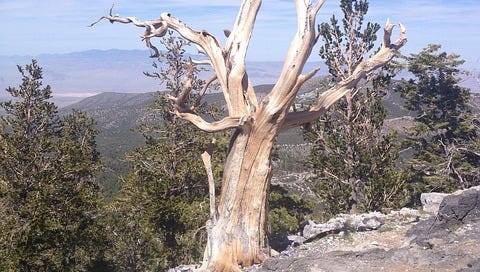Bristlecone Pine, Ancient of the Rockies
Why should we pay attention to this astounding tree?
photo thanks to mcanzon at Pixabay.com
by Pam Sherman
Why should we pay attention to this astounding tree?
For one, our Rocky Mountain bristlecone pine, Pinus aristata, provides watershed and erosion protection. It is extremely drought tolerant and can also tolerate some toxic conditions and has potential value in restoring old mine and other polluted sites. It can survive a low-intensity surface fire due to a few deep roots (the rest are shallow).
Two, it’s an integral part of our mountain landscape. There is some concern about its viability in climate change, so the more alert we are to what it needs and how it’s doing, the better.
Three, character. If you are landscaping, the Colorado Tree Coalition advises: “Plant as a single species in a rock garden or other well-drained site. It is not a formal looking tree. It develops ‘character.’” For amazing photos and info, check out this U.S. Geological Survey doc: Growth Form Characteristics of Ancient Rocky Mountain Bristlecone Pines (Pinus Aristata) Colorado.
Where is it native?
Native to the upper montane and subalpine, from about 9,000 to 11,000 feet,
It has been planted on the plains and can grow between the plains and the subalpine; the latter is its most comfy area, a land of bitter cold, ferocious winds, soil that is arid, mineral-poor, acidic and rocky.
When young, the bark is smooth and light grey. As the tree ages, the bark develops deep fissures (steep “canyons” in bark) and turns a reddish-brown. They can (but often don’t) grow up to about sixty feet.
In its natural short growing season, it grows slowly.
How ancient is the Rocky Mountain bristlecone pine?
Bristlecones are some of the oldest trees in the world, almost 2500 years in Colorado, up to 4,800 years elsewhere.
After they die, they can be around for centuries. Older trees are shorter, twisty, gnarly works of nature’s art; check out Out There Colorado’s article and photos on these Strange Storied Trees.
What causes these fantastic shapes?
Erosion. The wood has historically been so resistant to rot-causing fungi and insects in its natural arid home area that it erodes (as do rocks) rather than rots. Our arid climate has previously protected Rocky Mountain bristlecone pines from blister rust and other infections.
Is Rocky Mountain bristlecone pine subject to pests and other problems in our current climate?
In modern times bristlecone is known to be susceptible to white pine blister rust and other parasitic and fungal infections. The USFS Pinus aristata monograph tells us that blister rust has infected mature Rocky Mountain bristlecone pines in northern Colorado; other areas are seriously at risk. Blister rust spreads mostly spreads in wet years. There are no known control methods that work. Bristlecones can take up to decades to die.
What companion plants grow here with Rocky Mountain bristlecone pine?
Gooseberries ( (Ribes montigenum) and other currants (Ribes spp.), two of bristlecone’s popular understory companions and delicious edibles, are the primary host of white pine blister rust.
Other shrubby companions are common juniper (Juniperus communis), dwarf bilberry (Vaccinium myrtillus) and Oregon-grape (Mahonia repens); all are medicinal and edible.
Other common understory plants are Arizona fescue (Festuca arizonica), Thurber fescue (F. thurberi), alpine clover (Trifolium dasyphyllum), tufted hairgrass (Deschampsia cespitosa), glaucous bluegrass (Poa glauca), bog sedge (Kobresia myosuroides) and other sedges (Carex spp.)
On the Front Range, its upper montane forest companions are lodgepole pine or/and quaking aspen.
You will find bristlecone pine trees together in habitat that varies from dense forest to open conifer woodlands or grasslands and savannas.
Why is it called bristlecone?
Rocky Mountain bristlecone pine’s species name, aristata means `having an awn, a bristly cluster of needles’; find an excellent photo of an awn in this 5280 article on bristlecones in Colorado and in the following link.
In this Colorado State Forest Service photo you’ll be able to see the white dots on the needles; they hold resin which helps protect the needles and thus the trees from fungal rot and insects. They also help the waxy needles resist freezing.
Bristlecones have 5 needles per needle packet. They stay on the tree up to 40 years.
The prickles on the scales of the dark purple female cones – as well as the bristly needle clusters on the dense branches – give this plant the name “bristlecone.”
Rocky Mountain Bristlecone Pines, ancient treasures of our mountains, inspire the kind of awe in many of us that is as necessary as food. Keeping their health on our radar can help us be savvy assistants, as needed, for these ancients in our mountain homes.
This article adapted from one on the same topic by the same author that appeared in Wild Ones Front Range newsletter Dec. 31 2023



